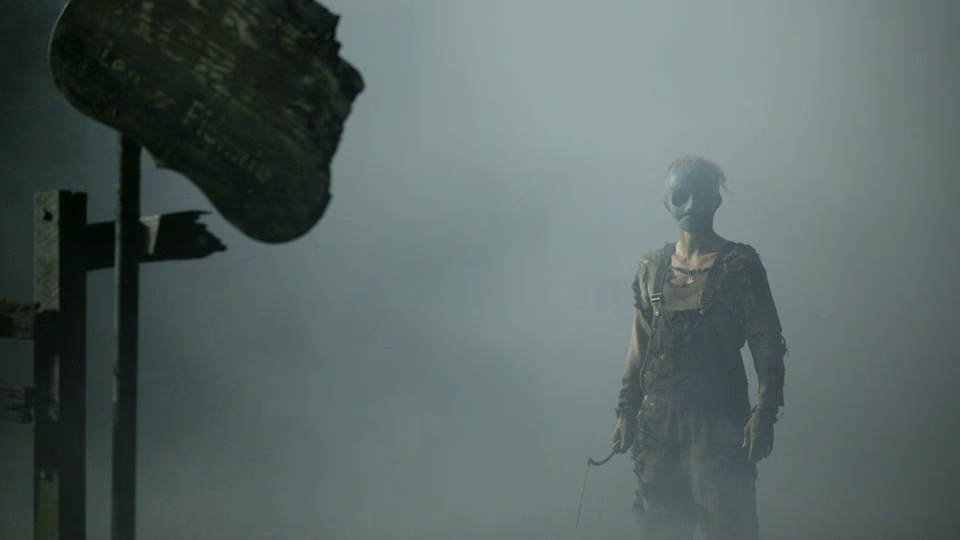Behind the Mask: The Rise of Leslie Vernon

A quasi-mockumentary set in a world where iconic horror killers like Jason Voorhees, Michael Myers, and Freddy Krueger are real historical figures. Taylor, a young journalist, leads a two-man crew into suburban Maryland to profile serial killer Leslie Vernon. They find Leslie charming and open as he presents a behind-the-scenes look at the work involved in maintaining the illusion of a supernatural killer. Spoilers follow.
“You have no idea how much cardio I have to do. It’s ridiculous,” says Leslie, sweating and catching his breath mid-workout in an early segment. “You’ve got to be able to run like a freakin’ gazelle without getting winded. Plus, there’s that whole thing about making it look like you’re walking while everybody else is running their asses off. And I gotta stay with ‘em! It’s tough, man!”
I laughed aloud. This sort of humor dominates Behind the Mask and I loved it. In another scene, Leslie explains the preparation work he’s done to a house: “There are eleven exits from the first floor and another eight or nine that might be manageable from the second floor. You want to eliminate as many as you can from being practical, so I’ve discreetly nailed them all shut.”
“Don’t they just smash them out?” asks Taylor.
“You’d think so…” replies Leslie, pausing for a beat. “But… you’d be surprised… No.” Then, warming to the thought, “And when they do smash them out, it’s on the second floor or higher. Then they’re out on the roof and they are screwed.”
This exchange had me roaring. It’s all in Nathan Baesel’s delivery as Leslie. His dynamic performance, exudes an infectious enthusiasm balanced with a craftsman’s attention to detail. He’s the ultimate genre fan and a clear sign the filmmakers are poking fun out of love, not derision. But Baesel also convinces as a killer, dimming the light in his eyes and shifting his entire presence from welcoming to menacing. A duel-role Baesel pulls off with aplomb.
As the film unfolds, we see through the crew’s video footage. It’s grainy and under-produced, but lends an air of realism. Leslie identifies his “survivor girl,” learns her movement patterns and studies her friends, then stages scenes to scare her and convince her of an invented backstory tying her to him. Slasher fans will recognize these beats and appreciate the humor inherit in the behind-the-scenes logistics. Everything from high-tech forgeries to fabricate old newspaper clippings to simple tricks like tying a fishing line to a door prop, so Leslie can yank it and create the illusion the door closed on its own.
Soon Taylor reaches a turning point. Hearing Leslie murder a teenage couple in an adjoining room proves a bridge too far, and she makes to leave.
Here the film may lose some viewers. Taylor has the crew turn off the cameras, and the film pivots from a mockumentary style to a straightforward slasher. First-person video gives way to third-person film. A score fills the silence. The once flat-lit house and woods now sport ominous shadows. Taylor’s conscience won’t let her abandon the other teens to Leslie, so she and her crew return to warn them.
Now the film proves capable of executing the very tropes it had satirized, delivering a kill-packed slasher finale with the twist that Taylor and her crew aren’t safe, but also that they know Leslie’s plans and believe they can outsmart him.
Indeed, in an earlier meeting with Leslie’s mentor Eugene, a now retired killer played with a similar mix of charm and menace by Scott Wilson, Taylor asks him for advice on surviving a serial killer encounter. “Pick a clear place in front of you, as far away as possible, and run,” Eugene replies. “And don’t ever, ever look back.”
Of course, they don’t take this advice and Leslie picks off the crew and the remaining teens one by one, leading to a final surprise involving the survivor girl’s identity that reframes the film as a trap movie.
This overlooked gem opens with Man Bites Dog’s setup: a documentary crew following a serial killer and becoming more complicit in his activities but the late pivot foreshadows The Cabin in the Woods, a meta-slasher proffering the big studio equivalent of Leslie’s one-man indie production albeit with the same behind-the-scenes perspective.
My biggest complaint lies with the video footage, which makes for a rougher-than-intended picture in today’s world of HD displays. Catching a 35mm projection is now on my bucket list.